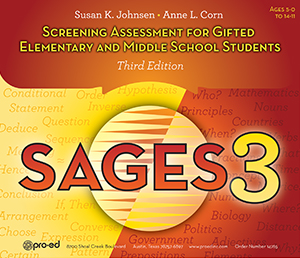Complete Kit Includes:
Examiner's Manual, 10
SAGES-3: K–3 Nonverbal Reasoning Student Response Booklets, 10
SAGES-3: K–3 Language Arts/Social Studies Student Response Booklets, 10
SAGES-3: K–3 Verbal Reasoning Student Response Booklets, 10
SAGES-3: K–3 Mathematics/ Science Student Response Booklets, 10
SAGES-3: 4–8 Nonverbal Reasoning Student Response Booklets, 10
SAGES-3: 4–8 Language Arts/Social Studies Student Response Booklets, 10
SAGES-3: 4–8 Verbal Reasoning Student Response Booklets, 10
SAGES-3: 4–8 Mathematics/Science Student Response Booklets, 50
SAGES-3: K–3 Examiner Record Forms, 50
SAGES-3: 4–8 Examiner Record Forms, and 1 SAGES-3:
4–8 Scoring Transparency, all in a sturdy storage box.
(SAGES-3) Screening Assessment for Gifted Elementary and Middle School Students
The Screening Assessment for Gifted Elementary and Middle School Student–Third Edition (SAGES-3) is a norm-referenced test used to identify students who are gifted and/or talented in general intellectual ability and academic aptitude.
Description of the Test
The SAGES-3 has two levels: SAGES-3: K–3 for students in kindergarten through third grade, and
SAGES-3: 4–8 for students in fourth through eighth grade. Each level has four subtests. The first subtest, Nonverbal Reasoning, measures the student’s ability to solve problems by identifying relationships among figures and pictures. The second subtest, Language Arts/Social Studies, measures the student’s achievement in language arts (i.e., literature, writing) and social studies. The third subtest, Verbal Reasoning, measures the student’s ability to solve problems by identifying the relationships between pairs of words, and the fourth subtest, Mathematics/Science, measures the student’s abilities in mathematics and science. The SAGES-3
provides two domain composites (Reasoning Ability and Academic Ability) and one overall composite (General Ability). The indexes of the Nonverbal Reasoning and Verbal Reasoning subtests combine to form the Reasoning Ability composite, and the indexes of the Language Arts/Social Studies and Mathematics/ Science subtests combine to form the Academic Ability composite. The four subtest indexes combine to form the General Ability composite. The Examiner’s Manual discusses the test’s theoretical and research-based foundation, item development, standardization, administration and scoring procedures, reliability and validity,
and guidelines for using and interpreting the test’s results.
The average coefficient alpha ranges between .81 and .96 for the subtests and from .91 to .98 for the composites. New validity studies demonstrate the test’s ability to differentiate students with high IQs (130 or higher) from students with lower IQs (below 130). The results demonstrate that for the SAGES-3: K–3, a General Ability index cutoff score of 126 resulted in a sensitivity of .74, a specificity of .96, and a ROC/AUC of .94. For the SAGES-3: 4–8, a General Ability index cutoff score of 120 resulted in a sensitivity of .80, a specificity of .88, and a ROC/AUC of .93.
Susan K. Johnsen / Anne L. Corn
Ages: 5 through 18 years
Administration: 10-50 minutes
Third Edition



